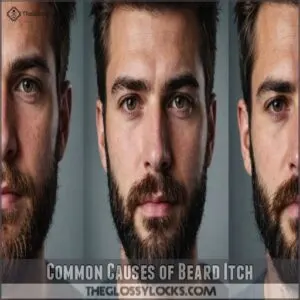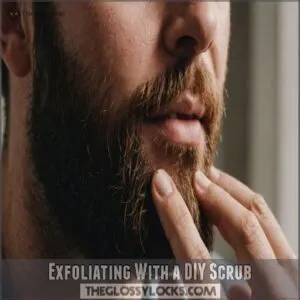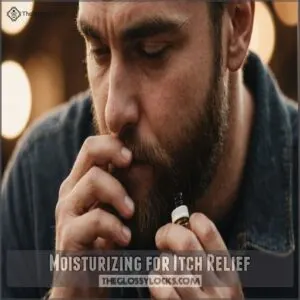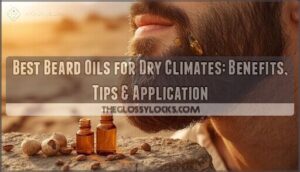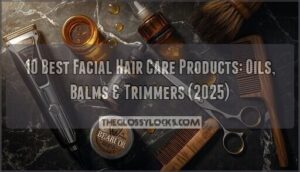This site is supported by our readers. We may earn a commission, at no cost to you, if you purchase through links.
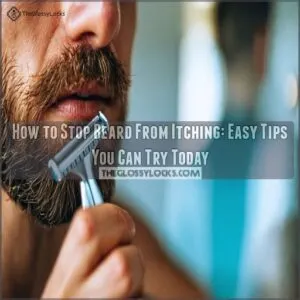
To stop your beard from itching, start by washing it daily with a quality beard shampoo to keep things clean and fresh.
Moisturize with beard oil containing jojoba or argan oil; they’re like a sip of iced tea for your hair.
Exfoliate gently to remove dead skin and prevent ingrown hairs.
Regularly brush and trim your beard—think of it as a workout routine for your facial fuzz.
Consider lifestyle tweaks too, like drinking more water.
Curious about the magic behind this? Keep reading!
Table Of Contents
- Key Takeaways
- Common Causes of Beard Itch
- Cleaning and Exfoliating for Beard Health
- Moisturizing for Itch Relief
- Trimming and Brushing for Beard Maintenance
- Home Remedies and Medical Treatments
- Nutrition and Lifestyle Changes
- Frequently Asked Questions (FAQs)
- How do you keep a beard from itching?
- What can I do for an itch that has suddenly become unbearable?
- How long does it take for a beard to stop itching?
- How to keep a beard Itch at arm’s length?
- What can I put on my beard to stop itching?
- Why is the skin under my beard so itchy?
- How to make a beard less prickly?
- Does beard oil cause itching?
- How long should I wait to shave again?
- Can beard style affect itchiness?
- Does beard dye contribute to itchiness?
- Do certain fabrics irritate beard skin?
- Is beard itch linked to skincare products?
- Conclusion
Key Takeaways
- Wash your beard daily with a quality beard shampoo and consider incorporating a beard care routine that includes a best beard moisturizer to reduce itchiness and promote healthy beard growth, and moisturize with beard oil to keep it clean and hydrated, reducing itchiness.
- Regularly exfoliate your skin to remove dead cells and prevent ingrown hairs, keeping your beard smooth and itch-free.
- Trim and brush your beard consistently to manage stray hairs and distribute natural oils, promoting a healthy and comfortable beard.
- Stay hydrated and maintain a balanced diet to support overall skin and beard health, minimizing dryness and irritation.
Common Causes of Beard Itch
When you start growing a beard, that itch can creep up on you faster than a cat eyeing its next nap, leaving you scratching like there’s no tomorrow.
This itch often stems from sharp, coarse hair breaking through your skin.
It can also be caused by issues like dry skin, folliculitis, and even conditions like seborrheic dermatitis, turning your new facial fuzz into an itchy nuisance.
Why New Beards Itch
When starting your beard journey, it’s like training stubborn wild hair to behave. New beards itch for several reasons:
- Sharp hair tips irritate skin
- Ingrown hairs cause bumps
- Hair follicle inflammation ignites discomfort
- Facial hair grows coarser
- Using gentle beard itch relief products, like those found in the beard itch relief shop, can help soothe these issues.
With patience and good beard care, such as gentle washing and moisturizing, you’ll find beard itch relief and enjoy a soft, stylish beard growth.
Impact of Dry Skin
Using a beard balm for dry skin, rich in essential oils and natural waxes, can significantly reduce itchiness learn more about beard balm for dry skin. Your beard’s dry skin is a common culprit behind that annoying itch.
Think of your beard like a thirsty desert; it needs hydration!
Dry skin under your beard creates friction, leading to irritation.
Regular moisturizing with beard oil is key for beard health and itch prevention.
A good skincare routine, including gentle cleansing and exfoliation, helps too.
Remember, a happy, hydrated beard is a less itchy beard!
Role of Folliculitis and Pseudofolliculitis
Dry skin isn’t the only villain here.
Folliculitis and its cousin, pseudofolliculitis barbae, love wreaking havoc on beards.
These conditions, better known as beard bumps and razor burns, cause inflammation and annoying itchiness from ingrown hairs.
Keep those pesky hairs at bay with proper beard hygiene, like regular brushing, and voila—you’ll be on your way to itch relief!
Other Medical Conditions
Alright, let’s face it—sometimes the itch isn’t just dry skin.
Imagine dealing with seborrheic dermatitis or tinea barbae. These guys love beards!
From staph infections to the surprise appearance of pubic lice (yes, really), underlying skin issues can play tricks on your face.
Monitoring symptoms and visiting a dermatologist can keep those pesky invaders at bay.
Cleaning and Exfoliating for Beard Health
Keeping your beard clean and free from itchiness is easier than you’d think—start by using a quality beard shampoo and adding a dash of exfoliation magic with a DIY scrub.
This combination tackles dirt and dead skin and also helps your beard feel as crisp as a winter morning, minus the chill.
Using Quality Beard Shampoo
Imagine this: you’re conquering your day, but those itchy whiskers ruin everything! A quality beard shampoo can tackle both dirt and dandruff, unlike that bar of soap. Look for natural ingredients like jojoba oil, which soothes skin. Don’t overdo it—twice a week is your sweet spot, as over-washing can lead to dryness and irritation, especially in arid climates where less washing is best how often to wash your beard. Trust me, it’s worth finding the best beard shampoos to keep that majestic mane itch-free and smelling divine.
- Check Ingredients: Opt for soothing oils.
- Shampoo Wisely: Twice weekly is perfect.
- Choose Wisely: Seek out the best options.
Exfoliating With a DIY Scrub
Tired of itchy beards and facial hair rash, this could be a symptom of underlying issues such as tinea barbae fungal infections. Tired of itchy beards and facial hair rash?
Mix up a simple DIY scrub!
Grab some baking soda and water, add a pinch of sea salt if you’re feeling adventurous—that’s your ticket to exfoliating bliss.
Do this once or twice a week, and you’re on your way to freedom from dry skin under your beard.
Sure, store-bought scrubs exist, but nothing beats homemade satisfaction!
Benefits of Regular Exfoliation
You’ve tried a DIY scrub, now let’s chat about why regular exfoliation should become your best friend for beard health.
It’s about more than just rubbing grit on your face.
With regular practice, you promote skin rejuvenation and fight those pesky ingrown hairs.
- Remove dead skin, improving beard hygiene.
- Encourage healthy hair growth.
- Using a beard care kit with vitamin E can help you achieve a healthy and moisturized beard. Keep your beard soft with regular care.
Moisturizing for Itch Relief
That annoying beard itch got you down? Let’s tackle it with some serious moisturizing – your skin and beard will thank you!
Benefits of Beard Oil
After scrubbing away the day’s grime, swap that rough beard for a silky, smooth one.
Beard oil becomes your new best friend, stopping beard itch in its tracks by moisturizing both hair and skin.
Think of it as a luxurious treat that tames wild facial hair, enhances beard growth, promotes skin health, and wards off pesky skin conditions like eczema.
Choosing The Right Beard Oil
Choosing the right beard oil might feel like picking a needle in a haystack, but here’s your cheat sheet. Look for:
- Beard oil ingredients: Opt for jojoba or argan oil.
- For sensitive skin: Seek out grapeseed oil.
- Essential oil blends: Calming lavender or invigorating peppermint.
- Carrier oil types: Using natural oils like jojoba oil, found in some of the best beard oil for itchy skin, helps to minimize seborrhea, combat psoriasis, and soothe itchy skin.
How to Apply Beard Oil
Feeling like a novice beardsman? Applying beard oil is easy. Simply drop oil onto your palm, rub hands together to warm it up, then massage through your beard and skin. Focus on the roots, not just the tips.
Here’s a quick guide:
| Beard Length | Oil Amount |
|---|---|
| Stubble | 2-4 drops |
| Short | 4-6 drops |
| Medium | 6-8 drops |
| Long | 8-10 drops |
| Epic | 10+ drops |
Keep those locks itch-free!
Using Beard Balm for Extra Moisture
Beard oil keeps things smooth, but for that next level itch relief, grab some beard balm.
Packed with moisturizing power, it locks in hydration and tames unruly hairs like a pro.
You can find a variety of beard balms online at stores like Everysimply Beard Balm.
Perfect for dry days or when your beard’s craving extra love.
Remember, like picking the perfect pizza topping, choosing the right balm can make all the difference.
Trimming and Brushing for Beard Maintenance
Trimming and brushing your beard might feel like grooming a particularly stubborn weed garden, but it’s essential for keeping that itch at bay.
Regular trims tame stray hairs, while brushing smooths things out but also distributes your beard’s natural oils, giving it a healthy shine and reducing those scratchy sensations.
Regular Trimming for Stray Hairs
Smooth and itch-free is a great place to be, and regular trimming keeps those pesky stray hairs in check.
Using the right beard razor types, coupled with sharpness impact considerations, means you’re cutting techniques will tackle ingrown hair prevention effectively.
Try trimming frequency adjustments based on your growth patterns—it’s like a mini spa day for your face, minus the cucumber slices.
Brushing for Hair Growth and Oil Distribution
How often should you brush your magnificent beard?
Daily brushing with a boar bristle beard brush is ideal.
This distributes your beard’s natural oils, preventing dryness and itch.
The boar bristle benefits are amazing for detangling, promoting healthy growth, and reducing oil absorption into your skin.
Remember, consistency is key!
A soft brush is gentler on sensitive skin.
Enjoy the process and your increasingly awesome beard!
Using a Beard Comb for Weak Hairs
After brushing for growth and oil spread, it’s time to embrace the beard comb and its perks.
Picture it as your beard’s personal assistant, expertly tackling weak hairs and preventing breakage.
Unlike brushes, combs offer precision, especially with tangled or stubborn strands.
Think of them like a gentle coaxer, nudging each hair into its rightful place, stimulating healthy growth.
Happy combing, and watch that beard flourish!
Home Remedies and Medical Treatments
Taming that itchy beard might require a combination of home remedies and some high-powered medical treatments, so let’s see what works best for your scratchy situation.
You might find relief with antifungal creams for tinea barbae, antibiotics for stubborn staph infections, or even photodynamic therapy if pseudofolliculitis isn’t playing nice; think of it as your beard care toolkit of champions.
Using Antifungal Creams for Tinea Barbae
Got a beard that itches like there’s a family of squirrels living in it?
Tinea barbae could be the culprit.
Using antifungal creams can help tame the itch monster.
Grab an over-the-counter option for mild cases, but don’t shy away from prescription creams if it’s stubborn.
Watch for side effects like irritation.
Sometimes, taking swift action with the right treatment makes all the difference for comfort.
Antibiotics for Staph Infections
Speaking of pesky fungi, staph infections can sneak in, causing some serious beard itch woes.
If you’re noticing staph infection symptoms—redness or pus—antibiotics might be your trusty sidekick.
Treating staph infections promptly reduces risks and complications.
Here’s how to tackle it:
- Visit a doctor for antibiotics.
- Maintain beard hygiene daily.
- Avoid sharing razors.
- Monitor for staph infection prevention.
Keep calm and beard on!
Photodynamic Therapy for Pseudofolliculitis
Ever considered photodynamic therapy for those persistent razor bumps?
It’s like a superhero for your skin, tackling pseudofolliculitis with precision.
While it’s effective, mind the costs and potential side effects.
Weigh your options carefully.
For instance, hormonal changes, such as fluctuations in estrogen, testosterone, and thyroid hormones, can trigger hair thinning or shedding, as seen in receding hairline causes.
Here’s a quick peek:
| Aspect | Details |
|---|---|
| Success Rate | Generally high |
| Risks | Skin redness, swelling |
| Alternatives | Topicals, laser therapy |
Explore and consult; the choice is yours!
Nutrition and Lifestyle Changes
To keep your beard itch-free, think of your diet as the secret sauce—staying hydrated and eating well makes a world of difference.
Imagine your beard thanking you each time you reach for juicy fruits, crunchy nuts, or that occasional multivitamin to fill in any gaps.
Drinking Water for Hydration
Seriously, hydration is key.
Water intake is essential for healthy skin, and that includes the skin under your beard.
Think of your skin like a plant; it needs water to thrive.
Drinking enough water also helps to enhance circulation to the scalp, carrying necessary nutrients to hair follicles and promoting overall skin health, as seen in the benefits of hydration levels for hair growth.
Aim for at least eight glasses of daily water.
This simple hydration tip boosts skin health, making your beard softer and less itchy.
Water benefits your whole body, inside and out.
Don’t underestimate the power of plain old H2O for a happy, itch-free beard!
You’ll see a difference in your skin’s health and your beard’s overall condition.
Eating a Balanced Diet for Beard Health
Hydration’s crucial, but let’s talk about eating.
A balanced diet works wonders for beard health, keeping itch at bay.
Think of loading your plate with beard-friendly foods, rich in vitamins and minerals like leafy greens and nuts.
They support hair growth and thickness, combating dryness, and make using beard wash products even more effective.
Incorporate healthy fats, proteins, and whole grains.
It’s not just food—it’s fuel for your facial masterpiece.
Beard-Nourishing Foods and Supplements
Now that you’ve embraced a balanced diet, let’s chat about foods and supplements that can give your beard some extra TLC.
Think of them as your beard’s best friends in the pantry:
- Eggs: Packed with biotin and protein for strength.
- Nuts and seeds: Rich in healthy fats and zinc for thickness.
- Leafy greens: Full of vitamins to fend off itchiness.
Feast on these and watch your beard thrive!
Frequently Asked Questions (FAQs)
How do you keep a beard from itching?
Keep your beard from itching by washing it with gentle beard shampoo, exfoliating weekly, and using quality beard oil or moisturizer.
Trimming regularly helps too.
Remember, a happy beard starts with pampering—don’t let it drive you whiskers-insane!
What can I do for an itch that has suddenly become unbearable?
Imagine this: your beard’s itching like ants at a picnic!
First, wash gently, then apply hydrocortisone cream to calm inflammation.
Don’t forget a good beard oil to lock in moisture.
If it persists, consult a doctor.
How long does it take for a beard to stop itching?
That pesky beard itch? It usually subsides within two to four weeks, but proper moisturizing and cleaning can greatly speed things up. Patience, my friend, it’ll get better!
How to keep a beard Itch at arm’s length?
Over 80% of new beardmen face uncomfortable itchiness.
Keep that beard itch at bay by using beard oil, regular brushing, and gentle exfoliation.
Add a splash of humor while scratching your head, not your beard.
What can I put on my beard to stop itching?
Use beard oil with jojoba to soothe itchiness.
Try argan oil for dry skin or grapeseed for sensitivity.
A quality beard balm locks in moisture, while regular exfoliation helps banish dead skin, making your beard itch-free.
Why is the skin under my beard so itchy?
Your itchy skin under the beard might stem from dry skin, tangled hairs, or follicle irritation.
Hydrate with beard oil, but consider using a beard conditioner for intense hydration properties, especially if you have a dry beard, to learn more about beard conditioner vs oil. Exfoliate gently to clear dead skin, and try moisturizing your skin regularly.
Keep your beard clean and conditioned.
How to make a beard less prickly?
Feeling like your beard’s a cactus?
Tame that prickliness by regularly moisturizing with beard oil or conditioner.
Trim those ends and brush daily to soften the hair, spreading natural oils.
Keep a soft touch, chap!
Does beard oil cause itching?
Beard oil can cause itching for 20% of folks with sensitive skin due to certain ingredients.
If you notice discomfort, try switching to an oil with simpler components like jojoba or almond to soothe your skin.
How long should I wait to shave again?
Wait about two to three weeks to shave again, giving your skin time to recover and avoid irritation.
This pause helps reduce redness and pesky razor bumps.
Maintain a moisturizing routine with beard oil to soothe any itchiness.
Can beard style affect itchiness?
Curly or wavy beard styles can indeed cause more itchiness. Those styles trap moisture and irritate skin. Consider a shorter, straighter style for less itch. It’s a simple solution!
Does beard dye contribute to itchiness?
Using beard dye can sometimes cause itchiness due to chemicals like ammonia or peroxide.
If your skin’s sensitive, look for dyes labeled "hypoallergenic" or "natural."
Always do a patch test before fully dyeing your beard.
Do certain fabrics irritate beard skin?
Nearly 45% of people find synthetic fabrics like polyester and acrylic can irritate beard skin, sparking flare-ups and itchiness.
Switching to natural fibers such as cotton or wool often helps your beard breathe and stay comfy.
Is beard itch linked to skincare products?
You’re not alone if your skincare products cause beard itch.
Some ingredients, like alcohol and fragrance, can irritate your skin and make itching worse.
Opt for gentle, moisturizing products to soothe and prevent irritation.
Conclusion
To stop your beard from itching, don’t just scratch the surface—dive into these tips!
Keep your beard clean and soft with daily washes and high-quality beard oil, like you’re giving your facial hair a good drink.
Exfoliate regularly and trim to avoid pesky stray hairs.
Remember, small lifestyle tweaks like staying hydrated can make a big difference.
With these strategies, you’ll banish itching, giving your beard the comfort it deserves.

